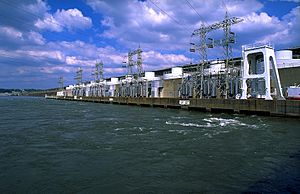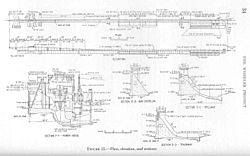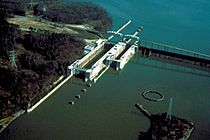Wheeler Dam facts for kids
Quick facts for kids Wheeler Dam |
|
|---|---|

Wheeler Dam
|
|
| Official name | Wheeler Dam |
| Location | Lauderdale / Lawrence counties, Alabama, United State |
| Coordinates | 34°48′25″N 87°22′55″W / 34.80694°N 87.38194°W |
| Construction began | November 21, 1933 |
| Opening date | November 9, 1936 |
| Operator(s) | Tennessee Valley Authority |
| Dam and spillways | |
| Impounds | Tennessee River |
| Height | 72 ft (22 m) |
| Length | 6,342 ft (1,933 m) |
| Reservoir | |
| Creates | Wheeler Lake |
|
Wheeler Hydroelectric Project
|
|
| Lua error in Module:Location_map at line 420: attempt to index field 'wikibase' (a nil value). | |
| Nearest city | Rogersville, Alabama |
| NRHP reference No. | 16000431 |
| Added to NRHP | June 26, 2016 |
Wheeler Dam is a large hydroelectric dam on the Tennessee River in Alabama. It sits between Lauderdale County and Lawrence County. This dam is one of nine dams on the river managed by the Tennessee Valley Authority (TVA).
The TVA built Wheeler Dam in the mid-1930s. It was part of a big government plan called the New Deal. The main goals were to make it easier for boats to travel the river, control floods, and help the economy grow in the area. The dam creates Wheeler Lake, a large body of water. The water flowing out of Wheeler Dam goes into Wilson Lake.
Wheeler Dam is named after Civil War general and U.S. Congressman Joseph Wheeler. He was one of the first people to suggest that the government should develop the Muscle Shoals area. In 2016, the dam was added to the National Register of Historic Places. This means it's an important historical site.
Where is Wheeler Dam Located?
Wheeler Dam is about 275 miles (443 km) from where the Tennessee River flows into another river. It's a few miles downstream from where the Elk River joins the Tennessee River.
The dam is about 7 miles (11 km) southwest of Rogersville. It's also about 30 miles (48 km) downstream from Decatur. The lake behind the dam, Wheeler Lake, stretches for 74 miles (119 km) upriver to the Guntersville Dam. Wilson Dam and the city of Muscle Shoals are only about 15 miles (24 km) downstream from Wheeler Dam. You can drive across the top of the dam on Alabama State Route 101.
How Big is Wheeler Dam?
Wheeler Dam is 72 feet (22 meters) high. This makes it the shortest of the TVA's dams on the Tennessee River. The dam is 6,342 feet (1,933 meters) long across its top.
It can produce 411,800 kilowatts of electricity. This is enough power for many homes and businesses. The dam has 60 special gates called tainter gates. These gates can release a lot of water, up to 542,000 cubic feet (15,300 cubic meters) per second.
Wheeler Lake has 1,027 miles (1,653 km) of shoreline. It covers 67,070 acres (27,140 hectares) of water. The lake can hold a lot of extra water during floods, helping to protect areas downstream.
The dam also has two locks for boats. The main lock is 110 feet (34 meters) wide and 600 feet (180 meters) long. There's also a smaller lock. These locks can raise and lower boats up to 52 feet (16 meters) between Wheeler Lake and Wilson Lake. This allows ships to travel safely past the dam.
Building Wheeler Dam
The Tennessee River between Decatur and Florence used to have a big drop in elevation. This created fast-moving water and rocky areas called the Muscle Shoals and Elk River Shoals. These shoals made it very hard for boats to travel up and down the river. This meant the upper part of the Tennessee Valley was cut off from other major waterways.
In the 1800s, some canals were built to help boats, but they weren't big enough for large river traffic. In 1898, Congressman Joe Wheeler helped get money from the government to improve river travel. The Wilson Dam was built in the 1920s, which helped create a 6-foot (1.8-meter) deep channel. But even then, boats could only pass easily when the water was high.
The Army Corps of Engineers had planned to build a dam at the Wheeler site in the early 1930s. But the Tennessee Valley Authority (TVA) took over the project soon after it was created in 1933. Construction on Wheeler Dam began on November 21, 1933. It was the second big dam the TVA built, after Norris Dam.
Building Wheeler Dam was a huge project. The TVA had to buy 103,400 acres (41,800 hectares) of land. They also had to clear 31,228 acres (12,637 hectares) of land. Many families (840 of them) had to move their homes. About 176 graves were moved, and 30 miles (48 km) of roads had to be relocated.
The work started quickly to help people find jobs during the Great Depression. At its busiest, the project employed 4,700 workers. The TVA was new to building dams, so they got a lot of help from the Army Corps of Engineers and the U.S. Bureau of Reclamation for the dam's design. The Army Corps also designed and built the dam's locks.
Wheeler Dam was finished on November 9, 1936. It cost about $87,655,000 to build. After the dam was done, they continued to dredge (dig out) the river. This helped extend the navigation channel all the way to Guntersville Dam, which was being built at the time.
Images for kids






